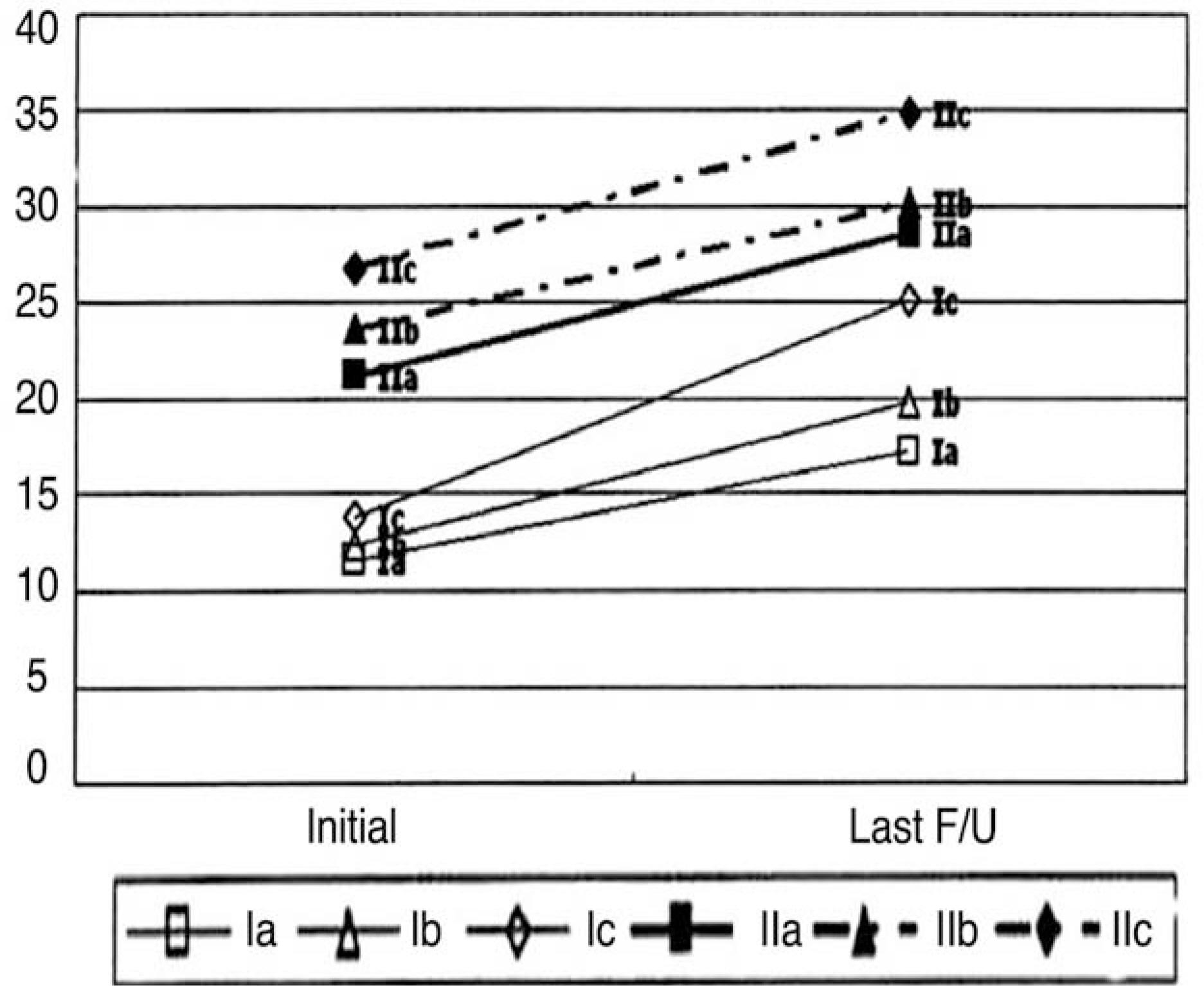J Korean Soc Spine Surg.
2006 Dec;13(4):247-254.
Classification and Treatment of Degenerative Lumbar Spinal Deformity
- Affiliations
-
- 1Department of Orthopedic Surgery, School of Medicine, Chungnam National University, Daejeon, Korea. jyyang@cnu.ac.kr
Abstract
-
STUDY DESIGN: A retrospective study
OBJECTIVE
To categorize and analyze clinical results of degenerative lumbar deformity patients according to the degree of scoliosis and kyphosis. SUMMARY AND LITERATURE REVIEW: A degenerative spinal deformity is classified into a coronal and sagittal deformity. There are some reports about treatment according to each classification but the classification is sometimes inappropriate and the treatment can vary.
MATERIALS AND METHODS
From June 1998 to June 2003, 79 patients, who were diagnosed with a degenerative lumbar deformity and underwent conservative or operative treatment, were studied retrospectively. Group I had scoliosis ranging from 10 to 20degrees , and group II had scoliosis > 20degrees Each group was subdivided into A, B, and C according to the lordosis, group A > 30degrees , group B between 20 to 30degrees , and group C < 20degrees . Scoliosis and lordosis were measured from the radiographs and the clinical results were evaluated using the Kirkaldy-Willis criteria and VAS score before and after surgery.
RESULTS
In group I, 9 cases underwent surgery and 11 cases underwent conservative treatment, without any significant differences in the clinical results. In group II, 35 cases underwent surgery and 24 cases underwent conservative treatment. Excellent results were obtained in 18(51.4%) cases, good in 15(42.9%) and 2(5.7%) were below fair. The average VAS score in group II given conservative treatment 8.9 preoperatively and 6.5 at the final follow up. Tn group II given surgical treatment the average VAS score was 9.2 preoperatively and 4.1 at the final follow up. There was a significant difference in the outcome (P < 0.05).
CONCLUSION
Patients with a degenerative lumbar deformity with accompanying lumbar scoliosis and kyphosis, scoliosis > 20degrees or lordosis < 20degrees are expected to show more improvement in symptom after surgery than after conservative treatment.
Keyword
MeSH Terms
Figure
Reference
-
1). Glassman SD, Berven S, Bridwell K, Horton W, Dimar JR. Correlation of radiographic parameters and clinical symptoms in adult scoliosis. Spine. 2005; 30:682–688.
Article2). Keller TS, Colloca CJ, Harrison DE, Harrison DD, Janik TJ. Influence of spine morphology on intervertebral disc loads and stresses in asymptomatic adults: Impli-cations for the ideal spine. Spine J. 2005; 5:297–309.
Article3). Legaye J, Duval-Beaupere G. Sagittal plane alignment of the spine and gravity: A radiological and clinical evaluation. Acta Orthop Belg. 2005; 71:213–220.4). Kirkaldy-Willis WH, Paine KW, Cauchoix J, McIvor G. Lumbar spinal stenosis. Clin Orthop Relat Res. 1974; 99:30–50.5). Bradford DS. Adult scoliosis. Current concepts of treatment. Clin Orthop Relat Res. 1988; 229:70–87.6). Lee CS, Kim YT, Kim EG. Clinical study of lumbar degenerative kyphosis. J Korean Soc Spine Surg. 1997; 4:27–35.7). Perennou D, Marcelli C, Herisson C, Simon L. Adult lumbar scoliosis. Epidemiologic aspects in a low-back pain population. Spine. 1994; 19:123–128.8). Takemitsu Y, Harada Y, Iwahara T, Miyamoto M, Miyatake Y. Lumbar degenerative kyphosis. Clinical, radiological and epidemiological studies. Spine. 1988; 13:1317–1326.9). Abei M. Correction of degenerative scoliosis of the lumbar spine. A preliminary report. Clin Orthop Relat Res. 1988; 232:80–86.10). Grubb SA, Lipscomb HJ. Diagnostic findings in painful adult scoliosis. Spine. 1992; 17:518–527.
Article11). Grubb SA, Lipscomb HJ, Suh PB. Results of surgical treatment of painful adult scoliosis. Spine. 1994; 19:1619–1627.
Article12). Bernhardt M. Normal spinal anatomy. Normal sagittal plane alignment. (in. Bridwell KH, Dewald RL, editors. The textbook of spinal surgery 2nded. Philadelphia: Lippin-cott-Raven;p. 185–191. 1997.13). Moon MS, Lee KS, Lim CI, Kim YB, Lee HS. A clinical study of degenerative lumbar scoliosis. Yonenobu K, editor. Lumbar fusion and stabilization. Springer-Verlag;p. 98–112. 1992.
Article14). Pritchett JW, Bortel DT. Degenerative symptomatic lumbar scoliosis. Spine. 1993; 18:700–703.
Article15). Toyama Y. Surgical management of degenerative lumbar scoliosis. Yonenobu K, editor. Lumbar fusion and stabilization. Springer-Verlag;113-134. 1992.
Article16). Kostuik JP. Recent advances in the treatment of painful adult scoliosis. Clin Orthop Relat Res. 1980; 147:238–252.
Article17). Lee JK, Yang JY, Kim KC. Surgical treatment of degenerative lumbar scoliosis with multiple spinal stenosis. J Korean Soc Spine Surg. 2002; 9:197–203.
Article18). Kostuik JP, Israel J, Hall JE. Scoliosis surgery in adult. Clin Orthop Relat Res. 1973; 93:225–234.
- Full Text Links
- Actions
-
Cited
- CITED
-
- Close
- Share
- Similar articles
-
- Clinical Implications of Spino-pelvic Parameters for the Outcome of Spinal Surgery for Lumbar Degenerative Diseases
- Radiological Evaluation and Classification of Adult Spinal Deformity
- Lumbosacral Fixation Using the Diagonal S2 Screw for Long Fusion in Degenerative Lumbar Deformity: Technical Note Involving 13 Cases
- Surgical Management of Spinal Stenosis with Degenerative Lumbar Scoliosis
- Surgical Treatment of Degenerative Lumbar Scoliosis with Multiple Spinal Stenosis







